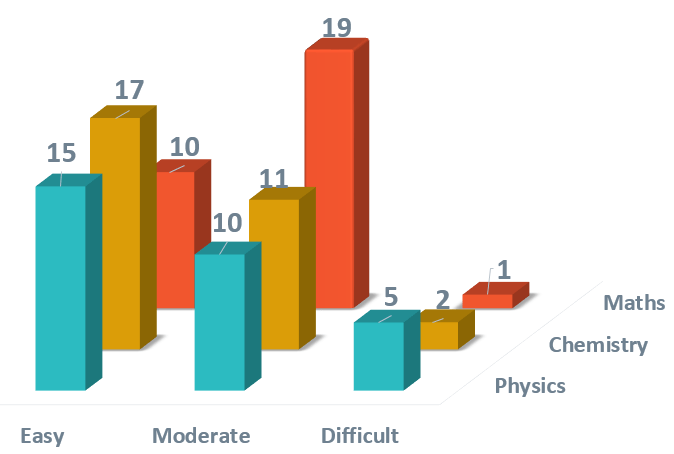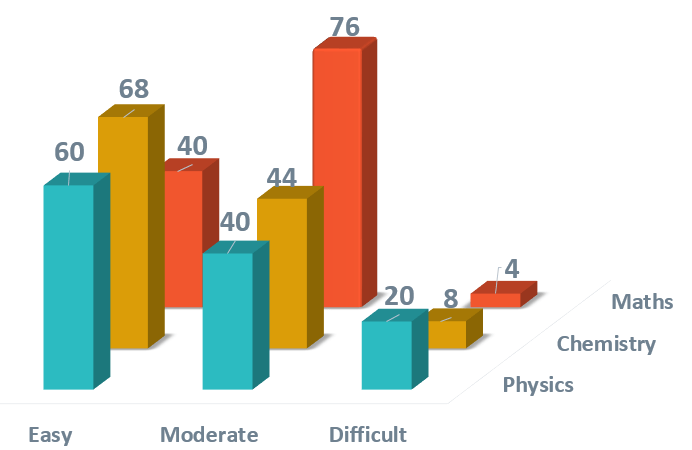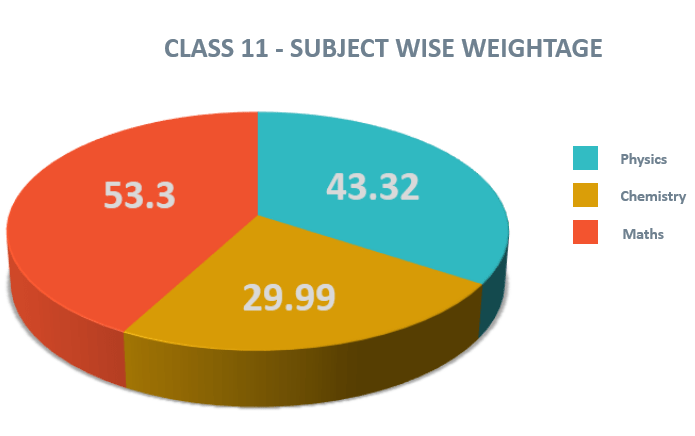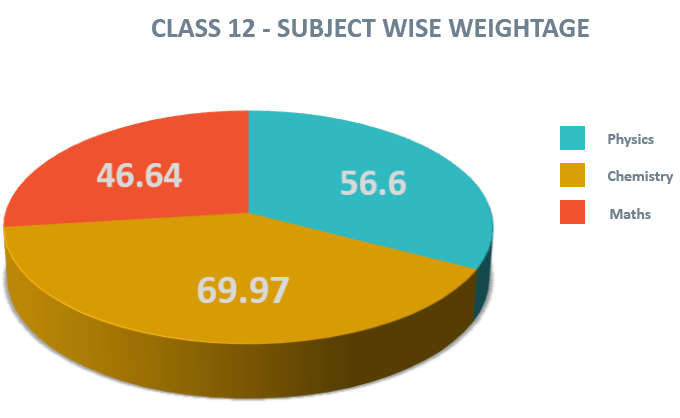
JEE Mains Exam is one of the most popular competitive exam conducted across the nation for admission in reputed engineering institutions by CBSE. It is the first phase of JEE and is conducted by CBSE every year to facilitate admissions into various undergraduate courses offered at NITs, IIITs, and other Government Funded Institutes. The exam was held in offline mode on April 8 and in online mode on April 15 & 16, 2018.
This year approximately 10,43,739 lakh students registered for Mains Exam. Out of these, only 2.24 lakh candidates will be selected for Advanced Exam.
The JEE Mains 2018 paper analysis gives an insight about the exam for its various aspects such as weightage given to 11th and 12th syllabus, difficulty level, distribution of topics and more.
For those who are interested in getting the reviews of the exam, read the full article to know more information about JEE Mains 2018 Paper Analysis. –
Given below is the paper analysis for only engineering aspirant’s i.e. Paper 1.
JEE Mains 2018 Paper Analysis - Difficulty Level Analysis:
Question Wise
| Subject | Easy | Moderate | Difficult | Total |
| Physics | 15 | 10 | 5 | 30 |
| Chemistry | 17 | 11 | 2 | 30 |
| Maths | 10 | 19 | 1 | 30 |
| Total | 42 | 40 | 8 | 90 |
Graphical Representation

JEE Mains 2018 Paper Analysis - Difficulty Level Analysis:
Marks Wise
| Subject | Easy | Moderate | Difficult | Total |
| Physics | 60 | 40 | 20 | 120 |
| Chemistry | 68 | 44 | 8 | 120 |
| Maths | 40 | 76 | 4 | 120 |
| Total | 168 | 160 | 32 | 360 |
Graphical Representation

JEE Mains 2018 Paper Analysis - Chapter Wise Distribution of Questions and Marks
1. Physics
| Sr. No. | Chapter Name | No. of Questions | Marks | % Weightage |
| 1 | GEOMETRICAL OPTICS | 0 | 0 | 0.00% |
| 2 | ELECROSTATICS | 1 | 4 | 3.33% |
| 3 | CURRENT ELECTRICITY | 3 | 12 | 10.00% |
| 4 | CAPACITOR | 1 | 4 | 3.33% |
| 5 | MAGNETIC EFFECT OF CURRENT & MAGNETISM | 2 | 8 | 6.67% |
| 6 | ELECTRO MAGNETIC INDUCTION | 0 | 0 | 0.00% |
| 7 | ALTERNATING CURRENT | 2 | 8 | 6.67% |
| 8 | FLUIDS | 0 | 0 | 0.00% |
| 9 | CALORIMETRY | 0 | 0 | 0.00% |
| 10 | KTG & THERMODYNAMICS | 2 | 8 | 6.67% |
| 11 | THERMAL EXPANSION | 0 | 0 | 0.00% |
| 12 | SHM | 1 | 4 | 3.33% |
| 13 | WAVE ON STRING | 0 | 0 | 0.00% |
| 14 | SOUND WAVES | 1 | 4 | 3.33% |
| 15 | KINEMATICS | 1 | 4 | 3.33% |
| 16 | WORK POWER ENERGY | 1 | 4 | 3.33% |
| 17 | CENTER OF MASS | 2 | 8 | 6.67% |
| 18 | ROTATIONAL DYNAMICS | 2 | 8 | 6.67% |
| 19 | MODERN PHYSICS | 2 | 8 | 6.67% |
| 20 | VECTORS | 0 | 0 | 0.00% |
| 21 | CALCULUS | 0 | 0 | 0.00% |
| 22 | NLM | 1 | 4 | 3.33% |
| 23 | ELASTICITY | 1 | 4 | 3.33% |
| 24 | UNIT & DIMENSION | 0 | 0 | 0.00% |
| 25 | WAVE OPTICS | 2 | 8 | 6.67% |
| 26 | GRAVITATION | 0 | 0 | 0.00% |
| 27 | ERRORS | 1 | 4 | 3.33% |
| 28 | CIRCULAR MOTION | 1 | 4 | 3.33% |
| 29 | ELECTRO MAGNETIC WAVES | 1 | 4 | 3.33% |
| 30 | SEMICONDUCTORS | 1 | 4 | 3.33% |
| 31 | PRACTICAL PHYSICS | 0 | 0 | 0.00% |
| 32 | COMMUNICATION SYSTEM | 1 | 4 | 3.33% |
| TOTAL | 30 | 120 | 100.00% |
2. Chemistry
| Sr. No. | Chapter Name | No. of Questions | Marks | % Weightage |
|
Inorganic Chemistry |
||||
| 1 | GENERAL CHEMISTRY | 0 | 0 | 0.00% |
| 2 | PERIODIC TABLE | 0 | 0 | 0.00% |
| 3 | CHEMICAL BONDING | 3 | 12 | 10.00% |
| 4 | COORDINATION CHEMISTRY | 2 | 8 | 6.67% |
| 5 | METALLURGY | 1 | 4 | 3.33% |
| 6 | SALT ANALYSIS | 1 | 4 | 3.33% |
| 7 | COMPLETE S-BLOCK | 0 | 0 | 0.00% |
| 8 | COMPLETE D-BLOCK | 0 | 0 | 0.00% |
| 9 | COMPLETE P-BLOCK | 2 | 8 | 6.67% |
| 10 | HYDROGEN AND ITS COMPOUND | 1 | 4 | 3.33% |
| 11 | ENVIRONMENTAL CHEMISTRY | 1 | 4 | 3.33% |
| 12 | F-BLOCK | 0 | 0 | 0.00% |
|
Organic Chemistry |
||||
| 1 | NOMENCLATURE | 0 | 0 | 0.00% |
| 2 | ELECTRONIC DISPLACEMENT EFFECT | 1 | 4 | 3.33% |
| 3 | ISOMERISM | 0 | 0 | 0.00% |
| 4 | HALOGEN DERIVATIVE | 2 | 8 | 6.67% |
| 5 | ALCOHOL & ETHER | 0 | 0 | 0.00% |
| 6 | HYDROCARBON | 1 | 4 | 3.33% |
| 7 | CARBONYL COMPOUNDS | 0 | 0 | 0.00% |
| 8 | CARBOXYLIC ACID ANDTHEIR DERIVATIVES | 0 | 0 | 0.00% |
| 9 | AMINES | 0 | 0 | 0.00% |
| 10 | AROMATIC COMPOUNDS | 2 | 8 | 6.67% |
| 11 | BIOMOLECULES | 1 | 4 | 3.33% |
| 12 | POLYMER | 0 | 0 | 0.00% |
| 13 | PRACTICAL ORGANIC CHEMISTRY | 1 | 4 | 3.33% |
| 14 | CHEMISTRY IN EVERYDAY LIFE | 1 | 4 | 3.33% |
|
Physical Chemistry |
||||
| 1 | MOLE CONCEPT | 1 | 4 | 3.33% |
| 2 | STOICHIOMETRY | 0 | 0 | 0.00% |
| 3 | CONCENTRATION TERMS | 0 | 0 | 0.00% |
| 4 | EUDIOMETRY | 0 | 0 | 0.00% |
| 5 | REDOX REACTIONS | 1 | 4 | 3.33% |
| 6 | IDEAL GAS | 0 | 0 | 0.00% |
| 7 | REAL GAS | 0 | 0 | 0.00% |
| 8 | ATOMIC STRUCTURE | 0 | 0 | 0.00% |
| 9 | CHEMICAL EQUILIBRIUM | 0 | 0 | 0.00% |
| 10 | IONIC EQUILIBRIUM | 2 | 8 | 6.67% |
| 11 | THERMODYNAMICS | 1 | 4 | 3.33% |
| 12 | THERMOCHEMISTRY | 1 | 4 | 3.33% |
| 13 | SOLID STATE | 1 | 4 | 3.33% |
| 14 | CHEMICAL KINETICS | 1 | 4 | 3.33% |
| 15 | RADIOACTIVITY | 0 | 0 | 0.00% |
| 16 | SURFACE CHEMISTRY | 0 | 0 | 0.00% |
| 17 | ELECTROCHEMISTRY | 1 | 4 | 3.33% |
| 18 | LIQUID SOLUTION | 1 | 4 | 3.33% |
| TOTAL | 30 | 120 | 100.00% | |
3. Mathematics
| Sr. No. | Chapter Name | No. of Questions | Marks | % Weightage |
| 1 | QUADRATIC EQUATION | 1 | 4 | 3.33% |
| 2 | SEQUENCE & SERIES | 2 | 8 | 6.67% |
| 3 | TRIGONOMETRIC RATIO IDENTITIES | 0 | 0 | 0.00% |
| 4 | TRIGONOMETRIC EQUATION | 1 | 4 | 3.33% |
| 5 | FUNCTION | 0 | 0 | 0.00% |
| 6 | INVERSE TRIGONOMETRIC FUNCTION | 0 | 0 | 0.00% |
| 7 | LIMIT | 1 | 4 | 3.33% |
| 8 | CONTINUITY | 0 | 0 | 0.00% |
| 9 | DIFFERENTIABILITY | 1 | 4 | 3.33% |
| 10 | METHOD OF DIFFERENTIATION | 0 | 0 | 0.00% |
| 11 | INDEFINITE INTEGRATION | 1 | 4 | 3.33% |
| 12 | DEFINITE INTEGRATION | 1 | 4 | 3.33% |
| 13 | DIFFERENTIAL EQUATION | 1 | 4 | 3.33% |
| 14 | AREA UNDER THE CURVE | 1 | 4 | 3.33% |
| 15 | STRAIGHT LINE | 2 | 8 | 6.67% |
| 16 | CIRCLE | 0 | 0 | 0.00% |
| 17 | VECTOR | 1 | 4 | 3.33% |
| 18 | 3-D | 2 | 8 | 6.67% |
| 19 | PERMUTATION & COMBINATION | 1 | 4 | 3.33% |
| 20 | PROBABILITY | 1 | 4 | 3.33% |
| 21 | COMPLEX NUMBERS | 1 | 4 | 3033% |
| 22 | BINOMIAL THEOREM | 1 | 4 | 3.33% |
| 23 | DETERMINANT | 2 | 8 | 6.67% |
| 24 | TANGENT & NORMAL | 1 | 4 | 3.33% |
| 25 | MONOTONICITY | 0 | 0 | 0.00% |
| 26 | MAXIMA & MINIMA | 1 | 4 | 3.33% |
| 27 | MATRICES | 0 | 0 | 0.00% |
| 28 | STATISTICS | 1 | 4 | 3.33 |
| 29 | PARABOLA | 1 | 4 | 3.33% |
| 30 | ELLIPSE | 1 | 4 | 3.33% |
| 31 | HYPERBOLA | 1 | 4 | 3033% |
| 32 | MATHEMATICAL REASONING | 1 | 4 | 3.33% |
| 33 | HEIGHT & DISTANCE | 1 | 4 | 3.33% |
| 34 | MATHEMATICAL INDUCTION | 0 | 0 | 0.00% |
| 35 | SETS | 1 | 4 | 3.33% |
| 36 | RELATION | 0 | 0 | 0.00% |
| Total | 30 | 120 | 100 |
JEE Mains 2018 Paper Analysis – Class Wise Analysis
Subject Wise Weightage (in %) – Class 11

Subject Wise Weightage (in %) – Class 12

Now, you have the complete analysis of the JEE Mains exam through which you can easily get the idea about the level of the question paper. Lets make your JEE Mains preparation easier with eSaral.
Hope you liked reading the above post. Please share it with your friends to help them in getting the relevant information.
Thanks!!
